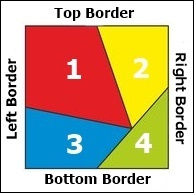
Borders
Borders are used to enhance the visual appeal and impact of images in various ways, including drawing attention to the subject, creating
a sense of space and structure, and improving the overall aesthetic. They can also be used for practical purposes like protecting the
image during handling or for branding and consistency in visual presentations. Bottom Border used to display the Title. You can define
the width of the Borders. They are sized equally. You can also define their background color, and in the case of the Bottom Border, define
the font color of the Title.
Canvas
Area inside the Borders, and contain the triangles. The Canvas corresponds to the file you uploaded, after it is squared if you
uploaded a rectangle image. If you opted to Use Grayscale, it is rendered without colors.
Triangles
Triangles are the root of Trianglism. To stay true to Trianglism, you cannot change the number of triangles. Nor can you alter their
number, or how they are arranged. They are precisely arranged. However, and at the heart of Trianglism, you can define their colors
and transparencies. That's the power of Trianglism.
Title
Title of your piece. Shown in Bottom Border.
Trianglized Specs
Specs of final product of tranglized canvas with borders. Define size (width x height).

